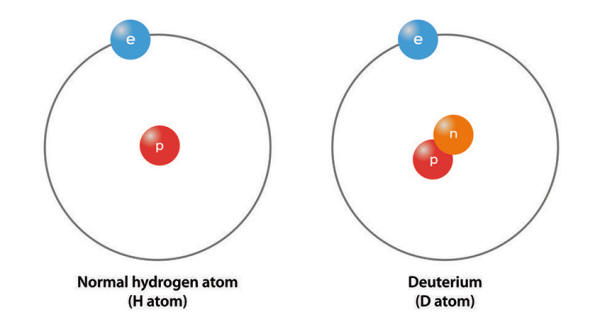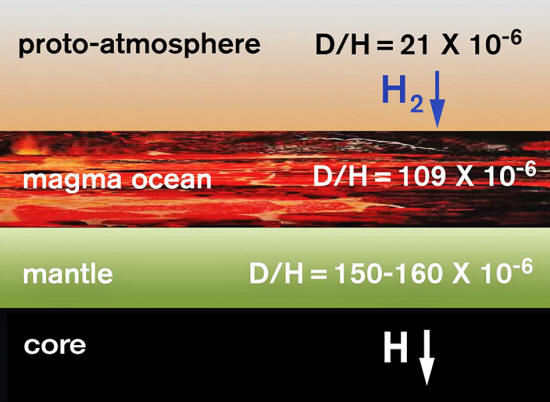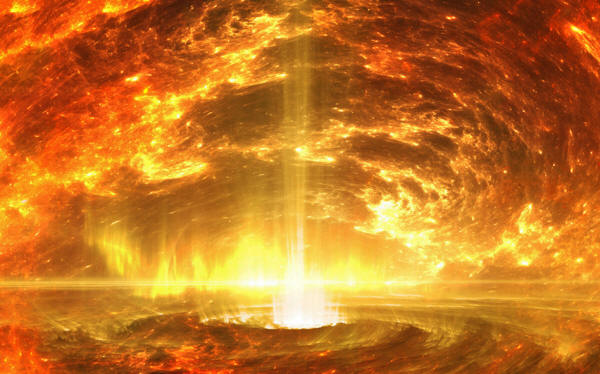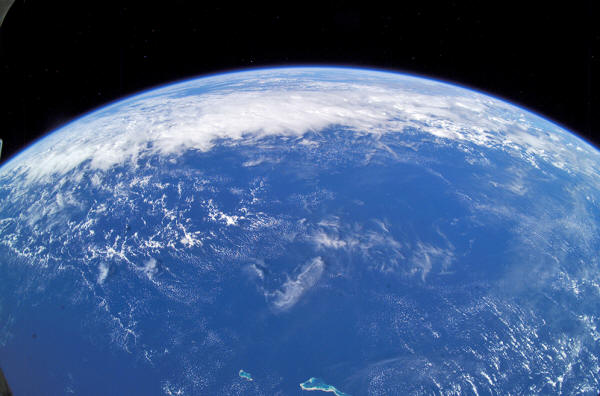|

by Robby Berman
November 16,
2018
from
BigThink Website

New Research
identifies an
Unexpected Source
for some of
Earth's Water...
-
A lot of Earth's water is asteroidal in origin, but
some of it may come from dissolved solar nebula gas.
-
Our planet hides majority of its water inside: two
oceans in the mantle and 4-5 in the core.
-
New reason to suspect that water is abundant
throughout the universe.
Scientists have puzzled for some time over how the Earth first
acquired water.
Some have theorized it
arrived in
cometary ice, or possibly aboard asteroids crashing onto
the planet's surface.
"But there's another
way to think about sources of water in the solar system's
formative days," says Arizona State University's Steven Desch, a
member of the team of geoscientists led by Peter Buseck,
Regents' Professor at ASU's School of Earth and Space
Exploration.
"Because water is
hydrogen plus oxygen, and oxygen is abundant, any source of
hydrogen could have served as the origin of Earth's water."
In a paper (Origin
of Earth's Water - Chondritic Inheritance Plus Nebular Ingassing and
Storage of Hydrogen in the Core) published in Journal
of Geophysical Research, the researchers suggest that the H in
our early H20 may have come from the rocky center of the
planet itself, left there during its formation.
If so, it may be
indicative of what happens on other rocky planets in our solar
system.
Heavy hydrogen

Image source:
gritsalak karalak
Shutterstock
Lead author of the paper, Jun Wu, tells
ASU,
"The solar nebula has
been given the least attention among existing theories, although
it was the predominant reservoir of hydrogen in our early solar
system."
Earth has three major
areas of water, the most visible of which is the ocean.
There are two more
"oceans," however, under the ground dissolved into the mantle. While
both hold the liquid, the water above and below ground is not quite
the same. It has to do with the presence of heavy hydrogen.
While far and away most hydrogen atoms have a nucleus containing a
single proton, the nucleus of about 1 in 7,000 hydrogen atoms has a
neutron as well.
These isotopes -
exceptions to the single-proton norm - are considered "heavy"
hydrogen atoms, or deuterium, abbreviated as "D."
Scientists can ascertain the source of hydrogen by determining its
ratio of D to A atoms, or its D/H ratio. The hydrogen in water from
comets has a D/H ratio ranging from 150 ppm (parts per million) to
300 ppm. Water from asteroids comes in at about 140 ppm. The D/H
ratio down deep in the earth that comes from solar nebulae is a
measly 21 ppm.
Most ocean water is about 150 ppm, suggesting that a lot of it is
asteroidal in origin, and, indeed, that's the going assumption.
But Wu suggests that
Earth's hydrogen has changed since it first got here, and that,
"This means we
shouldn't ignore the dissolved solar nebula gas."
Hydrogen to the core, deuterium to the mantle

Image source: Wu, et al
The change to which Wu refers is what happened to the Earth's
earliest hydrogen.
His team studied the
planet's likely history as it collided with and collected cosmic
materials to expand from a moon-to-Mars-sized "planetary embryo" to
the form in which we find it.
Wu's team asserts that the iron in our planetary embryo became
molten and sank to become the Earth's core. As it did, it pulled
asteroidal hydrogen down with it.
Energy from later cosmic
collisions created a magma ocean at the surface, and the iron there
also pulled hydrogen, this time from solar nebulae, out of the
primitive atmosphere, and sank.
Eventually, Earth
collided with other planetary embryos, and each time a similar
process repeated. And down went all this hydrogen into the Earth's
core.
At the same time, deuterium, which isn't attracted as strongly to
iron, was left behind in the magma, mantle, and atmosphere. The net
result is that there's a lower D/H ratio in the core than elsewhere,
and that's where the hydrogen from cosmic nebulae is.
It probably had a much
higher ratio when it got here.
"Such processes not
only delivered countless hydrogen atoms from the mantle to the
core," says the research, "but also generated an appreciable
difference in hydrogen isotopic composition. . . between the
mantle and core."
It's this dissonance in
D/H ratios that makes the current belief in asteroidal hydrogen
alone as the source of our water perhaps too simple an explanation.
Water, water,
everywhere

Jurik Peter
Shutterstock
Steven Desch says,
"We calculated how
much hydrogen dissolved in these bodies' mantles could have
ended up in their cores. Then we compared this to recent
measurements of the D/H ratio in samples from Earth's deep
mantle."
Their calculations
revealed that, Wu explains,
"Our planet hides the
majority of its hydrogen inside, with roughly two global oceans'
worth in the mantle, four to five in the core, and of course,
one global ocean at the surface."
"The end result is that Earth likely formed with seven or eight
global oceans' worth of hydrogen," concludes Desch.
"The majority of this
indeed came from asteroidal sources. But a few tenths of an
ocean's worth of hydrogen came from the solar nebula gas."
Apparently about 1 in 100
of the water molecules we have on Earth today came from solar
nebulae hydrogen.
A particularly provocative conclusion the paper draws is that the
production of water may be an inevitable result of the process that
forms rocky planets such as ours.
As the paper says,
"These results
suggest inevitable formation of water on sufficiently large
rocky planets in extrasolar systems."
There may be water
all over the universe...
ASU Geoscientists Discover an Overlooked...
Source for Earth's Water
by Robert
Burnham
November 07,
2018
from
ASU Website

Planet Earth - or Planet Water?
ASU geoscientists have found that our home
contains within itself six or seven global oceans
worth of hydrogen, in addition to the ocean seen
here in a photo of the Pacific taken from
the International Space Station.
Photo by NASA
Where did
Earth's global ocean come from?
A team of Arizona State
University geoscientists led by Peter Buseck, Regents'
Professor in ASU's School of Earth and Space Exploration (SESE)
and School of Molecular Sciences, has found an answer in a
previously neglected source.
The team has also
discovered that our planet contains considerably more hydrogen, a
proxy for water, than scientists previously thought.
So where is
it?
Mostly down in our
planet's core, but more about that in a minute.
The bigger question is,
where did all this
come from in the first place?
"Comets contain a
lot of ices, and in theory could have supplied some water,"
said Steven Desch, professor of astrophysics in SESE and one
of the team scientists.
Asteroids, he added, are
a source as well, not as water-rich yet still plentiful.
"But there's
another way to think about sources of water in the solar
system's formative days," Desch explained.
"Because water is
hydrogen plus oxygen, and oxygen is abundant, any source of
hydrogen could have served as the origin of Earth's water."
In the
beginning
Hydrogen gas was the major ingredient in the solar nebula - the
gases and dust out of which the sun and planets formed.
If the abundant hydrogen
in the nebula could combine with Earth's rocky material as it
formed, that could be the ultimate origin of Earth's global ocean.
Jun Wu, the lead author of the paper (Origin
of Earth's Water - Chondritic Inheritance Plus Nebular Ingassing and
Storage of Hydrogen in the Core) the team has published
in the Journal of Geophysical Research, is an assistant
research professor in both SESE and the School of Molecular
Sciences.
"The
solar nebula has been given the
least attention among existing theories, although it was the
predominant reservoir of hydrogen in our early solar system," Wu
said.
But first, some
geochemical detective work.
To distinguish between sources of water, scientists turn to isotope
chemistry, measuring the ratio between two kinds of hydrogen. Nearly
all hydrogen atoms have a nucleus that's a single proton. But in
about one in 7,000 hydrogen atoms, the nucleus has a neutron in
addition to the proton.
This isotope is called
"heavy hydrogen," or
deuterium, symbolized as D.
The ratio of the number of D atoms to ordinary H atoms is called the
D/H ratio, and it serves as a fingerprint for where that hydrogen
came from.
For example,
-
asteroidal water
has a D/H of about 140 parts per million (ppm)
-
cometary water
runs higher, ranging from 150 ppm to as much as 300 ppm
Scientists know that
Earth has one global ocean of water on its surface and about two
more oceans of water dissolved in its mantle rocks.
That water has a D/H
ratio of about 150 ppm, making an asteroidal source a good match.
Comets?
With their higher D/H
ratios, comets are mostly not good sources.
And what's worse, the D/H
of hydrogen gas in the solar nebula was only 21 ppm, far too low to
supply large quantities of Earth's water. In fact, asteroidal
material is such a good match that previous researchers have
discounted the other sources.
But, said Wu and co-workers, other factors and processes have
changed the D/H of Earth's hydrogen, starting back when the planet
was first beginning to form.
Wu said,
"This means we
shouldn't ignore the
dissolved solar nebula gas."
Concentrating
hydrogen
The key lies in a process combining physics and geochemistry, which
the team found acted to concentrate hydrogen in the core while
raising the relative amount of deuterium in Earth's mantle.
The process began quite early as the sun's planets were starting to
form and grow through the merger of primitive building blocks called
planetary embryos.
These moon-to-Mars-size
objects grew very quickly in the early solar system, colliding and
accreting material from the solar nebula.
Within the embryos, decaying radioactive elements melted iron, which
grabbed asteroidal hydrogen and sank to form a core. The largest
embryo experienced collisional energy that melted its entire
surface, making what scientists call a
magma ocean.
Molten iron in the magma
snatched hydrogen out of the developing primitive atmosphere, which
derived from the solar nebula.
The iron carried this
hydrogen, along with hydrogen from other sources, down into the
embryo's mantle. Eventually the hydrogen became concentrated in the
embryo's core.
Meanwhile another important process was going on between molten iron
and hydrogen. Deuterium atoms do not like iron as much as their H
counterparts, thus causing a slight enrichment of H in the molten
iron and leaving relatively more D behind in the magma.
In this way, the core
gradually developed a lower D/H ratio than the silicate mantle,
which formed after the magma ocean cooled.
All this was stage one. Stage two
followed as embryos collided and merged to become the proto-Earth.
Once again a magma ocean
developed on the surface, and once more, leftover iron and hydrogen
may have undergone similar processes as in stage one, thus
completing the delivery of the two elements to the core of the
proto-Earth.
Wu added,
"Besides the hydrogen
that the embryos captured, we expect they also caught some
carbon, nitrogen and noble gases from the early solar nebula.
These should have
left some isotope traces in the chemistry of the deepest rocks,
which we can look for."
The team modeled the
process and checked its predictions against samples of mantle rocks,
which are rare today at Earth's surface.
"We calculated how
much hydrogen dissolved in these bodies' mantles could have
ended up in their cores," said Desch. "Then we compared this to
recent measurements of the D/H ratio in samples from Earth's
deep mantle."
This let the team set
limits on how much hydrogen is in Earth's core and mantle.
"The end result,"
said Desch, "is that Earth likely formed with seven or eight
global oceans' worth of hydrogen. The majority of this indeed
came from asteroidal sources.
But a few tenths of
an ocean's worth of hydrogen came from the solar nebula gas."
Adding up the quantities
cached in several places, Wu said,
"Our planet hides the
majority of its hydrogen inside, with roughly two global oceans'
worth in the mantle, four to five in the core, and of course,
one global ocean at the surface."
Not just for
our solar system
The new finding, the team said, fits neatly into current theories
for how the sun and planets formed.
It also has implications
for
habitable planets beyond the solar
system. Astronomers have discovered more than 3,800 planets
orbiting other stars, and many appear to be rocky bodies not greatly
different from our own.
Many of these
exoplanets might have formed far
from the zones where water-rich asteroids and other building blocks
might have arisen. Yet they still could have collected hydrogen gas
from their own stars' solar nebulas in the way that Earth did.
The team concluded,
"Our results suggest
that forming water is likely inevitable on
sufficiently large rocky planets in extrasolar systems."
The authors of the paper
are,
-
Jun Wu
-
Steven Desch
-
Laura Schaefer
-
Linda Elkins-Tanton
-
Kaveh Pahlevan
-
Peter Buseck,
...all affiliated with
SESE.
Wu and Buseck are also
affiliated with ASU's School of Molecular Sciences. The research was
funded by the
Keck Foundation. Based in Los
Angeles, the W.M. Keck Foundation was established in 1954 by
the late W.M. Keck, founder of the
Superior Oil Company.
|






